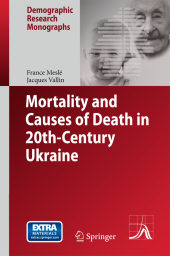 Neuerscheinungen 2014Stand: 2020-02-01 |
Schnellsuche
ISBN/Stichwort/Autor
|
Herderstra▀e 10
10625 Berlin
Tel.: 030 315 714 16
Fax 030 315 714 14
info@buchspektrum.de |

Sergei Adamets, France MeslÚ, Serhii Pyrozhkov, Vladimir Shkolnikov, Jacques Vallin
(Beteiligte)
Mortality and Causes of Death in 20th-Century Ukraine
Mitarbeit: Shkolnikov, Vladimir; Pyrozhkov, Serhii; Adamets, Sergei
2012. 2014. x, 282 S. 123 SW-Abb.,. 235 mm
Verlag/Jahr: SPRINGER NETHERLANDS; SPRINGER, BERLIN 2014
ISBN: 9401783403 (9401783403)
Neue ISBN: 978-9401783408 (9789401783408)
Preis und Lieferzeit: Bitte klicken
With unwonted precision, this volume reassesses the demographic impacts on the Ukraine of the 1933 famine precipitated by Stalin┤s agrarian policies as well as the traumas of the Second World War and the negative trends in life expectancy since the 1960s.
The Ukraine faced two very different kinds of health crises during the twentieth century. First, in the 1930s and 1940s, famine, war and political upheaval caused massive population losses. Previous evaluations of overall losses have given an idea of the scale of these catastrophes but do not distinguish between crisis mortality, birth shortfall and loss through emigration. Based on a painstaking work of reconstitution, this study is the first to provide a detailed estimation of the hecatomb in terms of number of deaths and life expectancy. The famine of 1933 was alone responsible for the deaths of 2.6 million Ukrainians and reduced male and female life expectancies to 7 and 11 years respectively. Once the crises of the 1930s and 1940s were over, the earlier trend in health resumed and mortality declined steadily until the 1960s. At this point, however, a new type of crisis appeared that caused a sustained reversal in the existing trends. Life expectancy for women stopped increasing altogether, while that for men began a relentless year on year regression. Notwithstanding the confusing picture created by the fluctuations of the 1980s and 1990s, the long-term trend is to further deterioration. To understand the factors involved, this study analyses in detail the combined effects of different causes of death at different ages._
General introduction.- Part one: Long-term trends in life expectancy and the consequences of major historical disasters.- Chapter 1: The crisis of the 1930s: Jacques Vallin, France MeslÚ, Sergei Adamets and Serhii Pyroshkov.- Chapter 2: The consequences of the second world war and the Stalinist repression: Jacques Vallin, France MeslÚ, Sergei Adamets and Serhii Pyroshkov.- Part two: Eighty years of trends in sex-specific and age-specific mortality.- Chapter 3 : Is mortality under-estimated?: France Mesl Ú, Jacques Vallin and Vladimir Shkolnikov.- Chapter 4: Eight years of sex-specific and age-specific mortality trends: France MeslÚ, Jacqyes Vallin and Vladimir Shkolnikov.- Chapter 5: Ukrainians and Russians in Ukraine and in Russia: Vladimir Shkolnikov.- Chapter 6: Health crises and cohort mortality: Vladimir Shkolnikov.- Part Three: Cause-specific mortality trends from 1965.- Chapter 7: Data Collection, data quality and the history of cause-of-death classification: Vladimir Shkolnikov, France MeslÚ and Jacques Vallin.- Chapter 8: Reconstructing series of deaths by cause with constant definitions: France MeslÚ and Jacques Vallin.- Chapter 9: General trends in mortality by cause: France MeslÚ and Jacques Vallin.- Chapter 10: Impact of major groups of causes on life expectancy trends: France MeslÚ, Jacques Vallin and Serhii Pyroshkov.- Chapter 11: Mortality trends by age group and detailed causes of death: France MeslÚ and Jacques Vallin.- Conclusion. _


